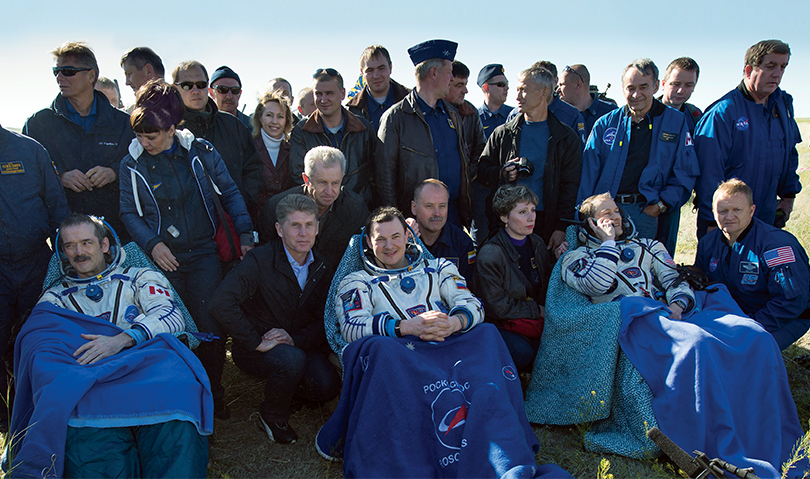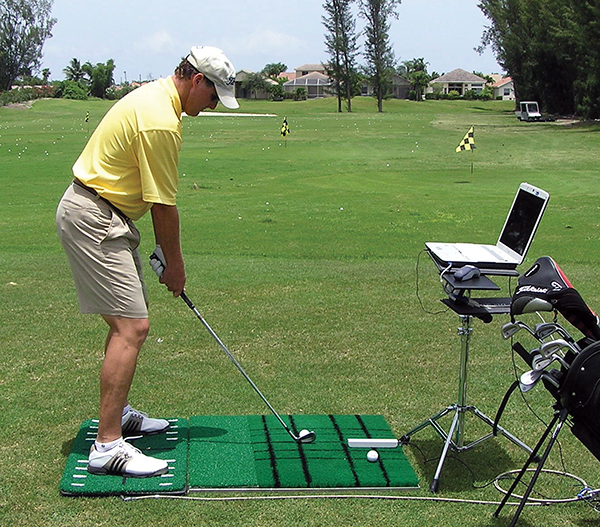
Balance Devices Train Golfers for a Consistent Swing
NASA Technology
After a stint in space, astronauts’ minds and bodies take some time to readjust to life on Earth. While the human body adapts relatively quickly to a lack of gravity (it takes only a few days), readapting to the pull of Earth’s gravity can take up to several weeks.
The adjustment starts before the astronauts ever land. In space, their blood pressure is equalized throughout their bodies. Their faces have more fluid and their legs have less, causing their faces to look fuller and their legs slimmer. On the ride home, as the astronauts leave orbit and feel Earth’s pull once again, blood rushes from their heads down to their feet, which makes them feel lightheaded.
NASA started studying the various effects of space flight on astronauts early in the space program. One example from the 1960s includes Massachusetts Institute of Technology doctoral candidate Lewis Nashner. Interested in understanding how different sensory and motor systems contribute to balance, Nashner performed NASA-funded research that resulted in a technology that proved useful for assessing the balance of astronauts after comingfrom space.
The technology incorporated a technique developed by Nashner called computerized dynamic posturography (CDP). His first device incorporating CDP was the EquiTest. This technology altered the surface that a person stood on as well as the visual surroundings, and then measured the responses and provided assessments of the person’s postural alignment and stability. His second device used the same CDP technique, but incorporated a screen that provided feedback about balance to the person using the machine. Called the Balance Master, it could not only diagnose but also help to train individuals with balance disorders.
Technology Transfer
After founding a company called NeuroCom (Spinoff 1996 and 2009), Nashner started offering the two systems for balance analysis and therapy to benefit individuals other than astronauts—including people suffering from vertigo, dizziness, the effects of a fall, or other balance problems.
In 1997, a physical therapist and athletic trainer named Dan Goldstein learned about the Balance Master and purchased one for his business. “In my physical therapy practice, I work with a lot of orthopedic and sports injuries,” says Goldstein. “I was unable to rehabilitate the balance deficits for these patients, so I obtained the NeuroCom technology.”
In addition to helping the patients in his physical therapy practice, Goldstein says he also realized he could help another group of people—golfers. “It is important for golfers to learn what proper balance feels like in order to achieve a consistent golf swing,” he says.
Goldstein soon started working with Nashner, and the partners co-patented a modified version of NeuroCom’s Balance Master to assist and train athletes, especially golfers. Now, Goldstein provides a product called the Dynamic Balance System (DBS) through his West Palm Beach, Florida-based business, Sports Therapy Inc.
Benefits
The DBS from Sports Therapy has two main components: a shifting force platform that a person stands on and a computer connected to the platform that displays balance data. As a person tries to balance, the computer provides a real-time display of his or her balance and center-of-gravity movement. The technology monitors the heels, toes, weight transfer, and rotational movements while recording the motion of the center of gravity.
Along with specific screens for full swing, pitching, and chipping and putting, there is also audio feedback to help in training specific repetitive movements. A golfer can see their results on a monitor and after several seconds, repeat the swing routine and hit again, as if practicing at a driving range. Their progress is documented and saved on the computer for future comparisons. Individuals can use the technology to practice with a trainer or by themselves.
Based on immediate feedback related to balance, golfers are able to connect balance to certain movements and then repeat them. This way, Goldstein explains, golfers can learn what balance feels like. Instead of the old adage, “Practice makes perfect,” Goldstein likes to say, “Only perfect practice makes perfect.”
“We look for repetitive body movement within our defined ‘balance zone’ and repetitive position of the body’s center of gravity at ball contact,” says Goldstein. “These factors have been shown to improve consistency and also reduce the chance of injury. A balanced swing causes less physical strain, which helps to reduce the risk of injury.”
Goldstein says golfers with orthopedic problems, limited mobility, amputations, and neurological conditions can also benefit from the DBS. “The immediate feedback capabilities of the technology can assist anyone in learning the feel of a consistent, repetitive swing motion,” he says.
Currently, there are 128 units being used around the world for physical therapy and sports training in hospitals, medical clinics, country clubs, and golf schools. Some of the organizations that Goldstein has partnered with include the Professional Golfers’ Association’s (PGA) Center for Golf Performance and Learning, the PGA Tour Academies, the Leadbetter Golf Academy, and Keiser School of Golf.
Sports performance specialists, physical therapists, athletic trainers, exercise physiologists, strength and conditioning coaches, and personal trainers are using the DBS not only for golf but to help people practice and train for tennis, karate, bowling, and dance.
Goldstein says he looks forward to cultivating even more applications for the DBS in baseball and basketball and for people who have lost a limb. In a case study by Goldstein, the DBS was shown to help someone with an above-the-knee amputation improve his golf game as well as experience less pain. “The immediate feedback is exceptionally helpful for amputees,” says Goldstein.
The DBS has proven to be yet another valuable example of how NASA technology returnsfrom space to improve the lives of people on Earth.

The Dynamic Balance System from Sports Therapy helps golfers learn what proper balance feels like, not only improving their golf swing but helping them prevent injuries, too.

Following five months onboard the International Space Station, Expedition 35 astronauts Chris Hadfield, Roman Romanenko, and Tom Marshburn sit in chairs outside the Soyuz Capsule they used to return. Having landed just minutes before, their bodies require extra support as they begin to adjust once again to the full effects of Earth’s gravity.













